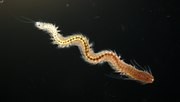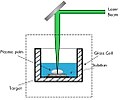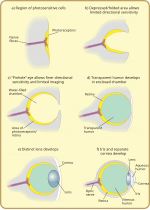placed into the genus Nereis and later reassigned to the genus Platynereis. Platynereis dumerilii lives in coastal marine waters from temperate to tropical...
34 KB (3,577 words) - 03:27, 17 October 2024
Platynereis is a genus of marine annelid worms that belongs to the Nereididae, a family of errant polychaete worms. The species Platynereis dumerilii...
4 KB (324 words) - 01:07, 19 December 2023
may look very different than atokes. For instance, the atokes of Platynereis dumerilii are yellowish-brown, while the female epitokes are yellow because...
5 KB (577 words) - 02:23, 3 December 2023
the advantages of reducing water loss and preventing dehydration. Platynereis dumerilii, a marine polychaete worm, uses uric acid as a sexual pheromone...
39 KB (3,928 words) - 13:56, 15 October 2024
use of those nerves. Another example is the trochophore larva of Platynereis dumerilii, where the larval eye was ablated and the larvae was not phototactic...
25 KB (3,200 words) - 01:12, 14 July 2024
synchronized spawning. Another marine animal, the bristle worm Platynereis dumerilii, spawns a few days after a full moon. It contains a protein with...
43 KB (4,887 words) - 11:22, 23 September 2024
Phototaxis has been well studied in the marine ragworm Platynereis dumerilii. Both Platynereis dumerilii trochophore and its metatrochophore larvae are positively...
57 KB (6,306 words) - 14:01, 26 June 2024
insects and crustaceans, and some annelids (notably the ragworm Platynereis dumerilii). They are known to play a role in olfactory learning and memory...
29 KB (3,400 words) - 23:32, 26 April 2024
panopsin was found in the ciliary photoreceptor cells of the annelid Platynereis dumerilii and is called c(iliary)-opsin. This c-opsin is UV-sensitive (λmax...
83 KB (8,995 words) - 19:04, 16 October 2024
the other type of photoreceptor cells, for instance the clamworm Platynereis dumerilii uses microvilliar cells in the eyes but has additionally deep brain...
46 KB (5,506 words) - 20:48, 21 October 2024









